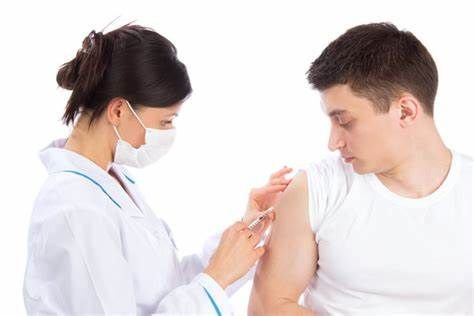Diversity Family Health BLOG
Find Information, Education, and Interesting Articles

Sexually transmitted infections (STIs) are a significant health concern for individuals worldwide, and certain populations, such as men who have sex with men (MSM), face specific challenges when it comes to sexual health. MSM are at a higher risk of contracting and transmitting STIs due to various factors. In this blog, we will explore the most common STIs among MSM, risk factors, preventive measures, and the importance of regular testing.
1. Common STI’s among MSM:
- Human Immunodeficiency Virus (HIV) : HIV is a viral infection that attacks the immune system, leading to AIDS if left untreated. MSM account for a significant portion of new HIV diagnoses globally. Regular testing and the use of pre-exposure prophylaxis (PrEP) can reduce the risk of HIV transmission. HIV is very treatable and those that are on treatment and undetectable cannot transmit the virus. Besides knowing your status, being on PrEP or HIV treatment are the best ways to prevent the spread of HIV.
- Syphilis: Syphilis is a bacterial infection that can affect multiple organs. MSM have seen a surge in syphilis cases, particularly among those engaging in high-risk sexual behaviors. Timely diagnosis and treatment are crucial to prevent complications.
- Gonorrhea and Chlamydia: These bacterial infections can occur in various parts of the body, including the genitals, rectum, and throat. MSM are at an increased risk due to unprotected anal and oral sex. Regular testing, using condoms and silicone lubricants (when engaging in receptive anal sex) can help prevent the spread of these infections.
- Human Papillomavirus (HPV): Most sexually active people have acquired HPV by adulthood. It is contracted by skin-to-skin contact and most commonly detected in the genital, anal, and oral cavity. MSM have increased risk of anal cancer due to HPV related anal cancers. Those that are HIV positive have an even greater risk than those that are HIV negative. Vaccination and screening for high-risk types of HPV should be performed on all MSM after age 30 for those that are HIV positive and over 40 for those that are HIV negative.
- Monkey Pox (MPox): Most recently a variation of the small pox virus has plagued the MSM community. Mpox is transmitted through skin to skin contact and most commonly transmitted in large group events. MSM should be vaccinated to prevent contracting Mpox.
2. Risk Factors:
- Condomless Sexual Activity: Engaging in anal or oral sex without the use of barriers, such as condoms or dental dams, significantly increases the risk of STI transmission.
- Multiple Sexual Partners: Having multiple sexual partners can increase the likelihood of encountering STIs. It is crucial to discuss sexual health with partners and use barriers consistently.
- Substance Abuse: Substance use, especially drugs like methamphetamine, can lead to risky sexual behaviors and impair judgment, further increasing the risk of STI transmission. Alcohol should not be discounted as a substance that can reduce inhibitions leading to decisions that can raise the risk of contracting STI’s.
3. Preventive Measures:
- Using Condoms: Consistently using condoms or dental dams during anal and oral sex can reduce the risk of STI transmission. Water-based lubricants can also help minimize the chance of condom breakage. Water-based or silicone-based lubricants are safe to use with all types of condoms. Oil-based lubricants, such as petroleum jelly, lotion, or baby oil, can break down latex, polyurethane, or polyisoprene condoms, leading to failure during intercourse. Spermicide is also safe to use with condoms. It is important to never use two condoms at once.
- Regular Testing: Regular STI testing is essential for early detection and prompt treatment. MSM should consider getting tested every three to six months or as recommended by healthcare professionals. Diversity Family Health recommends getting tested before engaging with a new partner and 7 days after a sexual encounter with every new partner. Diversity Family Health walk-in STI clinic is a convenient way to get regular testing.
- Vaccinations: Vaccines, such as the HPV vaccine (now available up to age of 45) and the hepatitis A and B vaccines, can provide protection against certain STIs. Consult with a healthcare provider to determine the appropriate vaccinations for your individual needs.
- Pre-Exposure Prophylaxis (PrEP): PrEP is available for the prevention of HIV. Oral PrEP is a pill, when taken daily can prevent HIV. Alternatively, injectable PrEP can be taken on the same day every two months to prevent HIV. Both oral and injectable PrEP when taken as directed have proven to reduce the risk of HIV transmission by 99%.
- Post-Exposure Prophylaxis (PEP): There are two forms of PEP, one for HIV and one for Chlamydia, Gonorrhea, and Syphilis. HIV P EP: When not on PrEP, medication can be taken to prevent getting HIV if the medication is started within 72 hours of exposure. This medication is taken for 28 days and is very effective at preventing HIV infection. Doxy-PEP: Doxycycline has been proven to prevent chlamydia and syphilis up to 66% when taken, preferably, within 24 hours but no later than 72 hours after a condomless sexual encounter. It can also be effective against gonorrhea, however 25% of gonorrhea in the US is resistant to doxycycline.
- Treatment as Prevention: Those that are positive for HIV can also prevent the spread of HIV by taking their medication as prescribed. If a person’s viral load (the number of HIV virus detected in the blood) are less than 200 they are considered undetectable and they cannot transmit the virus to others. Rarely is HIV transmitted by someone who knows they are HIV positive.
4. Importance of Communication, Education & Support:
- Open Communication: Honest and open communication with sexual partners is vital for preventing STI’s. Discussing sexual health, STI testing history, and potential risks can help make informed decisions.
- Education and Awareness: Promoting comprehensive sex education and raising awareness about STIs within the MSM community is crucial. Accessible information can empower individuals to make informed choices and seek appropriate healthcare.
- LGBTQ+ Healthcare Providers: Seeking healthcare from LGBTQ+-experienced providers who are knowledgeable about MSM sexual health can ensure better understanding and support. Book your sexual health appointment with Diversity Family Health.
Conclusion: Sexually transmitted infections remain a concern for men who have sex with men, but with knowledge, communication, and preventive measures, the risk can be significantly reduced. Regular testing (knowing your status), implementing prevention strategies, and open dialogue with healthcare providers and sexual partners are crucial steps in maintaining sexual health and well-being. Remember, taking care of your sexual health is an important aspect of leading a fulfilling and healthy life.

Bacterial vaginosis (BV) is a common vaginal infection that affects all people assigned female at birth (AFAB) regardless of sexual orientation. While BV can occur in any AFAB, including lesbians and transgender men. it is important to raise awareness about prevention strategies specifically tailored to this community. In this blog post, we will explore what BV is, its potential causes, and provide practical tips for preventing BV for all people AFAB, including lesbians and transgender men.
Understanding Bacterial Vaginosis (BV): BV is a vaginal infection caused by an imbalance in the natural bacterial flora of the vagina. Normally, the vagina contains a delicate balance of good and bad bacteria. However, when the bad bacteria outnumber the good bacteria, it can lead to symptoms such as unusual vaginal discharge, odor, itching, and discomfort.
Prevention Strategies: Preventing BV involves adopting certain practices and habits that promote a healthy vaginal environment. Here are some key strategies to consider:
1. Maintain Good Vaginal Hygiene:
- Use mild, unscented soaps and avoid douching, as it disrupts the natural pH balance of the vagina.
- After using the toilet, wipe from front to back to prevent the spread of bacteria from the anus to the vagina.
2. Sex Practices
- Engaging in informed sexual practices can reduce the risk of BV and other sexually transmitted infections (STIs). For lesbian couples, it is essential to pay attention to hygiene practices before and after sexual activity.
- Consider using barrier methods such as dental dams or gloves during oral-genital or manual-genital contact to reduce the risk of bacterial transfer.
3. Limit Antibiotic Use
- Overuse of antibiotics can disrupt the vaginal microbiome, potentially leading to an imbalance and increased risk of BV
- Whenever possible, discuss with your healthcare provider alternative treatment options that do not involve antibiotics or explore strategies to minimize their impact on the vaginal flora.
4. Wear Breathable Underwear and Clothing:
- Wearing breathable cotton underwear and avoiding tight-fitting clothing can help prevent excessive moisture buildup and create an unfavorable environment for bacterial overgrowth.
- Latex and silicone packers can also cause for extra moisture buildup in transgender men. Wicking fabrics to keep the area dry should be between the packer and the body.
5. Probiotics:
- Probiotics, available as oral supplements or vaginal suppositories, can help restore and maintain a healthy balance of vaginal bacteria. Consider discussing with your healthcare provider to determine the most suitable option for you.
6. Regular Health Check-ups:
- Routine gynecological exams and screenings are crucial for early detection and treatment of any vaginal infections or abnormalities. Regular visits to your healthcare provider will help ensure your overall vaginal health.
Conclusion: Preventing bacterial vaginosis is important for all people AFAB, including lesbians and transgender men, to maintain optimal vaginal health. By implementing these preventive strategies, you can promote a healthy vaginal environment and reduce the risk of BV. Remember, open communication with healthcare providers and sexual partners, and implementing prevention strategies, are key components of maintaining good vaginal health.
It is vital to emphasize that sexual orientation and gender identity does not determine the risk of developing BV. All people AFAB, regardless of their sexual orientation, can benefit from these preventive measures. Prioritize your well-being and take proactive steps towards promoting vaginal health for a happier and healthier life.

Human papillomavirus (HPV) is one of the most common sexually transmitted infections (STIs) worldwide. While it affects both men and women, certain populations, such as men who have sex with men (MSM) and transgender women (TW), face unique challenges and risks related to HPV transmission and associated health issues. In this blog post, we will delve into the topic of HPV in MSM/TW, exploring its prevalence, transmission, potential health implications, prevention strategies, and the importance of regular screenings.
Understanding HPV: HPV is a group of viruses that can be transmitted through various forms of sexual contact, including penile, vaginal, anal, and oral sex. It is estimated that there are over 200 different types of HPV, out of which approximately 40 types can infect the genital area. These can be further classified as low-risk and high-risk types based on their association with various health conditions.
Prevalence in MSM/TW: Research indicates that MSM/TW are at a higher risk of acquiring HPV compared to heterosexual men. This is primarily due to factors such as the nature of sexual practices involved, including receptive anal sex, which can facilitate the transmission of HPV. Studies have shown that up to 70-90% of HIV-positive MSM are infected with at least one type of HPV. Additionally, the prevalence of anal HPV infection among HIV-negative MSM can range from 20% to 70%, depending on the specific population studied.
Health Implications: While most HPV infections resolve on their own without causing any significant health issues, persistent infection with certain high-risk types can lead to the development of various conditions. In MSM/TW, the most concerning outcome is the increased risk of anal cancer. Studies have shown that the incidence of anal cancer is significantly higher among MSM/TW compared to the general population. Other HPV-related conditions, such as genital warts, oral and throat cancers, can also affect MSM/TW.
Prevention and Screening: Preventing HPV transmission is crucial for MSM/TW to reduce the risk of associated health problems. Here are some key prevention strategies to consider:
1. Vaccination: The HPV vaccine is available for both males and females, and it is recommended for MSM/TW up to age 45. Vaccination provides protection against the most common high-risk and low-risk types of HPV, reducing the risk of infection and related complications.
2. Condom Use: Consistent and correct use of condoms during anal sex can help reduce the risk of HPV transmission. However, since HPV can also infect areas not covered by condoms, such as the scrotum or upper thighs, condoms do not provide complete protection.
3. Regular Screenings: Routine screenings are essential for early detection and treatment of HPV-related conditions. For MSM/TW, this should include regular anal Pap smears and visual inspections conducted by healthcare professionals trained in anal health.
Conclusion: HPV is a prevalent STI among MSM/TW, with significant implications for their health. Understanding the risks, transmission methods, and potential health issues associated with HPV is crucial for MSM/TW to make informed decisions about their sexual health. By adopting preventive measures such as vaccination, using condoms, and regular screenings, MSM/TW can actively reduce their risk of acquiring and transmitting HPV, thereby safeguarding their overall well-being.
Remember, open and honest communication with healthcare providers and sexual partners is paramount to maintaining good sexual health. Stay informed, get vaccinated, and prioritize regular screenings for a healthier future. The providers at Diversity Family Health are skilled in the appropriate prevention and screening for HPV and HPV related anal cancers in MSM/TW. Make an appointment to discuss your sexual health needs at your convenience.
When discussing sexually transmitted infections (STIs), the focus is often centered around heterosexual or gay male relationships. However, it's crucial to acknowledge that STIs can affect individuals in all types of sexual relationships, including lesbian relationships. In this blog, we will explore common STIs among lesbians, risk factors, preventive measures, and the importance of regular testing and open communication.
1. Common STIs Among Lesbians:
- Human Papillomavirus (HPV): HPV is a viral infection that can lead to genital warts and increase the risk of certain cancers. Although HPV is commonly associated with heterosexual transmission in women, it can still be transmitted between female partners through skin-to-skin contact. Vaccination and regular Pap smears can help detect and prevent HPV-related complications.
- Bacterial Vaginosis (BV): BV is a common vaginal infection caused by an imbalance of bacteria. While the exact transmission methods are not fully understood, it can occur between female partners. Maintaining good vaginal hygiene and avoiding douching can help reduce the risk of BV.
- Herpes Simplex Virus (HSV): HSV is a viral infection that causes outbreaks of painful sores or blisters. Transmission can occur through direct contact with the infected area or through oral-genital contact. Using barriers, such as dental dams, during oral sex and avoiding contact during outbreaks can minimize the risk of transmission.
2. Risk Factors:
- Multiple Sexual Partners: Having multiple sexual partners can increase the risk of STI transmission, regardless of sexual orientation. It's important to have open and honest discussions about sexual health with partners.
- Sharing Sex Toys: Sharing sex toys without proper cleaning or using barriers can increase the risk of STI transmission. Clean toys thoroughly or use condoms on them between partners. Diversity Family Health has private labeled a great toy cleaning solution developed to reduce transmission of STI’s.
3. Preventive Measures:
- Barriers: Using barrier protection can reduce the risk of STI transmission. Using barriers, such as dental dams or gloves, during oral sex, and using condoms or gloves during manual or penetrative sex can provide protection. Proper cleaning and disinfection of sex toys are also essential.
- Regular Testing: Regular STI testing is crucial, regardless of sexual orientation. It's recommended to get tested regularly, especially if there has been a change in sexual partners. Healthcare providers can guide individuals on appropriate testing schedules based on specific needs.
- Vaccinations: Vaccines like the HPV vaccine can provide protection against certain strains of the virus, reducing the risk of HPV-related complications.
4. Open Communication and Support:
- Honest Discussions: Open and honest communication with partners about sexual health, testing history, and potential risks is essential. Creating a safe space for discussing concerns or questions can foster trust and promote informed sexual behaviors.
- LGBTQ+ Healthcare Providers: Seeking healthcare from LGBTQ+-experienced providers who are knowledgeable about lesbian sexual health can ensure better understanding and support. Book your sexual health appointment with Diversity Family Health.
Conclusion: Sexually transmitted infections can affect individuals in all types of sexual relationships, including lesbian relationships. Through regular testing, implementing prevention strategies, and open communication, lesbians can prioritize their sexual health and well-being. Remember, being proactive about sexual health is an important aspect of maintaining a healthy and fulfilling life, regardless of sexual orientation.

For many transgender men, achieving a more authentic and comfortable sense of self involves addressing gender dysphoria in various ways. One popular option is using a packer, a prosthetic device designed to create the appearance of a male genitalia. While packers can be an empowering tool for gender affirmation, it is important to prioritize safety and well-being during their use. In this blog, we will explore the best practices and guidelines for safe packer use in transgender men, with the aim of promoting a healthy and confident experience.
Understanding the Purpose of Packers:
Packers are prosthetic devices that can help transgender men feel more comfortable and authentic in their gender presentation. They can enhance self-confidence, alleviate dysphoria, and contribute to a sense of completeness. It is important to note that packers are not a medical solution, but rather a personal choice to enhance gender affirmation.
Choosing the Right Packer:
Selecting a packer that suits your needs and preferences is essential for comfort and overall satisfaction. Here are some key considerations:
1. Material: Packers are typically made from silicone or other body-safe materials. Choose a packer made from high-quality, non-toxic materials to minimize the risk of allergic reactions or skin irritation.
2. Size and Weight: Packers come in various sizes and weights. Consider your comfort level and lifestyle when selecting a packer. Some individuals prefer lighter packers for daily use, while others may opt for more realistic or heavier ones for specific occasions.
3. Realism: Determine how important realism is to you. Packers range from simple shapes to highly detailed replicas. Realistic options can enhance personal validation, but they may also require additional maintenance.
Safe Packer Use Practices:
To ensure a safe and positive experience with your packer, follow these guidelines:
1. Hygiene: Maintain good hygiene practices by cleaning your packer regularly. Use mild soap and warm water or follow the manufacturer's cleaning instructions. This helps prevent the buildup of bacteria and reduces the risk of infections.
2. Comfortable Harness or Underwear: Invest in a comfortable harness or specialized underwear designed to secure your packer in place. A well-fitted harness helps prevent shifting or discomfort during daily activities.
3. Skin Protection: If your packer comes into direct contact with your skin, consider using a barrier, such as a condom or a specialized packer pouch. This helps protect your skin from potential irritation and makes cleaning easier.
4. Skin Care: Keep the skin around the packer clean and dry. Moisturize regularly to prevent chafing or dryness. If you experience any skin irritation, discontinue use and consult a healthcare professional.
5. Packing Safety: Be mindful of your packer's positioning and the potential impact during physical activities. Avoid situations where the packer could cause injury, discomfort, or embarrassment.
Conclusion:
Packers can be valuable tools in the gender affirmation journey for transgender men, providing enhanced comfort, confidence, and self-expression. Prioritizing safe packer use is essential to ensure a positive experience. By choosing the right packer, following hygiene practices, and taking care of your skin, you can enhance your comfort and minimize potential risks. Remember, packers are a personal choice, and what matters most is your well-being and happiness. If you have any concerns or questions about packer use, do not hesitate to seek advice from healthcare professionals or transgender support groups.
For many transgender men, chest dysphoria can significantly impact their well-being and mental health. One popular option to alleviate this dysphoria is using a chest binder, a garment designed to flatten the chest and create a more masculine appearance. While binders can be an important tool for gender affirmation, it is crucial to prioritize safety and health during their use. In this blog, we will explore the best practices and guidelines for safe binder use in transgender men, aiming to promote a healthy and comfortable experience.
Understanding the Purpose of Binders:
Chest binders are specifically designed to compress and flatten the chest area, helping transgender men achieve a more masculine silhouette. It is important to recognize that binders should only be used for the purpose they are intended and should not be used as a substitute for proper healthcare or as a long-term solution.
Choosing the Right Binder:
Selecting a well-fitting binder is essential for both safety and comfort. Here are some key points to consider:
1. Size: It is crucial to choose a binder that fits correctly. Avoid binders that are too tight or constrictive, as they can restrict breathing and cause discomfort. Follow the manufacturer's sizing guidelines, and consider seeking advice from experienced binder users or transgender support groups.
2. Material: Opt for binders made from breathable, stretchable, and high-quality materials to ensure comfort and minimize skin irritation. Avoid binders with rigid or non-stretchable components.
3. Compression Level: Different binders offer varying levels of compression. Start with a lower compression level, especially if you are new to binder use, and gradually increase it based on your comfort and tolerance. Excessive compression can lead to breathing difficulties and other health issues.
Safe Binder Use Practices:
To ensure your well-being while using a binder, follow these guidelines:
1. Limit Duration: It is important to avoid wearing a binder for extended periods. Give your body regular breaks to recover and allow your chest to breathe. Experts recommend wearing binders for no more than 8-10 hours per day.
2. Rest Days: Designate rest days where you do not wear a binder at all. This allows your body to recover fully and reduces the risk of muscle strain, discomfort, and skin issues.
3. Listen to Your Body: Pay attention to any signs of discomfort, pain, difficulty breathing, or restricted movement. If you experience any of these symptoms, remove the binder immediately and seek medical advice if necessary.
4. Skin Care: Proper skin care is crucial when using a binder. Keep the chest area clean and dry, and moisturize regularly to prevent chafing and irritation. Avoid wearing a binder on broken or irritated skin.
5. Monitor Chest Health: Regularly examine your chest for any changes or abnormalities. If you notice any concerns, such as persistent pain, unusual lumps, or skin discoloration, seek medical advice promptly.
Conclusion:
Chest binders can be an important tool for transgender men to alleviate chest dysphoria and improve their overall well-being. However, safe binder use should always be a top priority. By choosing the right binder, following safe practices, and listening to your body's needs, you can enhance your comfort and minimize potential health risks. Remember, your health and well-being should always come first, so reach out to healthcare professionals or transgender support groups if you have any concerns or questions regarding binder use.
Get Local!
Learn more about our team and other specifics at your nearest DFH location.


